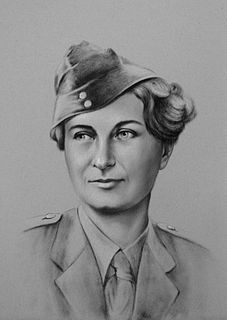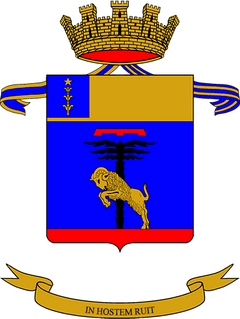Related Research Articles

Susan Mary Gillian Travers was an Englishwoman who served in the French Red Cross as a nurse and ambulance driver during the Second World War. She later became the only woman to be matriculated in the French Foreign Legion, having also served in Vietnam, during the First Indochina War.

The Battle of Bir Hakeim took place at Bir Hakeim, an oasis in the Libyan desert south and west of Tobruk, during the Battle of Gazala. The 1st Free French Brigade defended the position from 26 May – 11 June against much larger Axis forces of Panzerarmee Afrika. The Panzerarmee captured Tobruk ten days later but the delay imposed on the Axis offensive by the defence of the fortress influenced the cancellation of Operation Herkules, the plan for an Axis invasion of Malta. Rommel continued to advance and invaded Egypt, slowed by British delaying actions until the First Battle of El Alamein in July, where the Axis advance was stopped. Both sides used the battle for propaganda, Winston Churchill renamed the Free French as the Fighting French and Hitler called the French the second best fighters after the Germans.
The 1st South African Infantry Division was an infantry division of the army of the Union of South Africa. During World War II the division served in East Africa from 1940 to 1941 and in the Western Desert Campaign from 1941 to 1942. The division was disbanded on 1 January 1943, for conversion into what would become the 6th South African Armoured Division. The division was also briefly active after the war from 1 July 1948 to 1 November 1949.

Operation Crusader was a military operation of the Western Desert Campaign during the Second World War by the British Eighth Army, against the Axis forces in North Africa commanded by Generalleutnant Erwin Rommel. The operation was intended to by-pass Axis defences on the Egyptian–Libyan frontier, defeat the Axis armoured forces and relieve the 1941 Siege of Tobruk.

The Western Desert campaign, took place in the deserts of Egypt and Libya and was the main theatre in the North African campaign of the Second World War. Military operations began in June 1940 with the Italian declaration of war and the Italian invasion of Egypt in September. Operation Compass, a British five-day raid in December 1940, led to the destruction of the Italian 10th Army. Benito Mussolini sought help from Adolf Hitler, who sent a small German force to Tripoli under Directive 22. The Afrika Korps was formally under Italian command as Italy was the main Axis power in the Mediterranean and North Africa.

The Battle of Alam el Halfa took place between 30 August and 5 September 1942 south of El Alamein during the Western Desert Campaign of the Second World War. Panzerarmee Afrika, attempted an envelopment of the British Eighth Army. In Unternehmen Brandung, the last big Axis offensive of the Western Desert Campaign, Rommel intended to defeat the Eighth Army before Allied reinforcements arrived.

The Battle of Gazala was fought during the Western Desert Campaign of the Second World War, west of the port of Tobruk in Libya, from 26 May to 21 June 1942. Axis troops of the Panzerarmee Afrika consisting of German and Italian units fought the British Eighth Army composed mainly of British Commonwealth, Indian and Free French troops.

Bir Hakeim is in the Libyan desert at 31°36′00″N23°29′00″E and is the site of a former Ottoman Empire fort built around the site of an ancient Roman well, dating to the period when the oasis was part of Ottoman Tripolitania. It is about 160 kilometres (99 mi) west of Sollum on the Libyan coast and 80 kilometres (50 mi) south-east of Gazala. Bir Hakeim is best known for the battle of Bir Hakeim, which took place there during World War II.
This is a timeline of the North African campaign.

The 150th Infantry Brigade was an infantry formation of the British Army that saw active service in World War II. A 1st Line Territorial Army brigade, it was part of the 50th (Northumbrian) Infantry Division. It served in the Battle of France and was evacuated from Dunkirk. Later it served in the Middle East and was overrun and forced to surrender during the Battle of Gazala in the North African Campaign. For almost 72 hours during the battle the 150th Brigade and the 44th Royal Tank Regiment held out against Erwin Rommel's concentrated attacks, without any support. On 1 June the German Army finally forced their surrender. The brigade was not reformed.

The Battle of Mersa Matruh was fought from 26 to 29 June 1942, following the defeat of the Eighth Army at the Battle of Gazala and was part of the Western Desert Campaign of the Second World War. The combatants on the Axis side were the Axis Panzer Army Afrika (Panzerarmee Afrika, consisting of German and Italian units. The Allied forces of the Eighth Army comprised X Corps and XIII Corps. The battle developed as the Afrika Korps pursued the Eighth Army as it retreated into Egypt. Rommel intended to engage and destroy the Allied infantry formations in detail, before the British had a chance to regroup. The Axis cut off the line of retreat of X Corps and XIII Corps but was too weak to stop the British from breaking out. The fortress port of Mersa Matruh and 6,000 prisoners were captured, along with a great deal of supplies and equipment but the Eighth Army survived.
This is a timeline of events that occurred during World War II in 1942.

101st Motorised Division Trieste or 101° Divisione Trieste (Italian) was a Motorised Division of the Italian Army during World War II. The Trieste was formed in 1939 and served in Albania and North Africa where it surrendered to the Allies in 1943.

17th Infantry Division "Pavia" was an auto-transportable Infantry Division of the Italian Army during World War II. The Pavia Division was formed in October 1939 and sent to Libya. It was never completely motorised and was almost destroyed during the Second Battle of El Alamein. The Pavia was classified as an auto-transportable division, meaning staff and equipment could be transported on cars and trucks, although not simultaneously.

133rd Armoured Division Littorio or 133° Divisione Corazzata Littorio (Italian) was an armoured division of the Italian Army during World War II. The division was formed in 1939 from the Infantry Division Littorio that had taken part in the Spanish Civil War. It was a reserve unit during the invasion of France when it attacked through the Little St Bernard Pass, which was halted by the French defenders. It then took part in the Invasion of Yugoslavia, fighting at Mostar and Trebinje. It was sent to North Africa in the spring of 1942 where it fought until it was destroyed at the Second battle of El Alamein in November 1942.

The Eighth Army was a field army formation of the British Army during the Second World War, fighting in the North African and Italian campaigns. Units came from Australia, British India, Canada, Free French Forces, Greece, New Zealand, Poland, Rhodesia, South Africa and the United Kingdom.

French development into tanks began during World War I as an effort to overcome the stalemate of trench warfare, and largely at the initiative of the manufacturers. The Schneider CA1 was the first tank produced by France, and 400 units were built. The French also experimented with various tank designs, such as the Frot-Laffly landship, Boirault machine and Souain experiment. Another 400 Saint-Chamond tanks were manufactured from April 1917 to July 1918, however these tanks were largely underpowered and of limited utility due to the design of the caterpillar tracks, which were too short in comparison with the tank's length and weight. The most significant French tank development during the war was the Renault FT light tank, which set the general layout for future tank designs and was used or redesigned by various military forces, including those of the United States.

The Second Battle of Bir el Gubi was fought near Bir el Gubi, Libya, between 3 and 7 December 1941, between Italian and Commonwealth forces. It followed the First Battle of Bir el Gubi a failed Allied attempt to capture Bir el Gubi two weeks' previous. Bir el Gubi was a tactical position whose fall would have allowed the Allies to outflank the German-Italian forces in Cyrenaica. The battle was part of Operation Crusader.

The Axis capture of Tobruk, also known as the Fall of Tobruk and the Second Battle of Tobruk was part of the Western Desert Campaign in Libya during the Second World War. The battle was fought by Panzer Army Africa a German–Italian (Axis) military force in north Africa, which included the Afrika Korps, led by Generalleutnant Erwin Rommel) and forces from the United Kingdom, India, South Africa and Allied contingents in the British Eighth Army.

The 132nd Tank Regiment is a tank regiment of the Italian Army based in Cordenons in Friuli Venezia Giulia. Originally the regiment, like all Italian tank units, was part of the infantry, but since 1 June 1999 it is part of the cavalry. Operationally the regiment is assigned to the 132nd Armored Brigade "Ariete".
References
- 1 2 The Rommel Papers, pg.206
- ↑ Germany and the second World War, pg. 674
- ↑ Franz Kurowski: Panzer Aces II: Battle Stories of German Tank Commanders of WWII, pg. 259
- ↑ Germany and the second World War, pg. 667